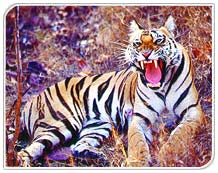Bandhavgarh Travel Guide
Bandhavgarh Home » About Bandhavgarh Travel Guide » Places to See
Excursions » How to Reach » Air Line Ticketing
Car Coach Rentals In Bandhavgarh » Tailormade Tours » Map »Travellers Tools
-------------------------------------------------------
About Bandhavgarh Travel Guide

This
is a small National Park; compact, yet full of game. The density of the tiger
population at Bandhavgarh is the highest known in India. This is also white
Tiger country. These have been found in the old state of Rewa for many years.
The last known was captured by maharaja Martand Singh in 1951 . This White
tiger , Mohun, is now stuffed and on display in the Palace of the Mahrahahs
of Rewa.
Bandhavgarh is densely populated with other species: the great gaur, or Indian
bison, can be seen with ease, as they come onto the meadows to graze at dusk;
sambar and barking deer are a common sight and nigai are to be seen in the
more open areas of the park.
The terrain is of great rocky hills rising sharply from the swampy and densely-forested
valley bottoms. The finest of these hills is Bandhavgarh, sided with great
cliffs and eroded rocks and on its highest point stands Bandhavgarh fort,
thought to be some 2,000 years old. Scattered throughout the park, and particularly
around the fort, are numerous caves containing shrines and ancient Sankrit
inscriptions.
Covering 448 sq km, Bandhavgarh is situated in Shahdol district among the
outlying hills of the vindhya range. At the centre of the Park is Bandhavgarh
hiss, rising 811 metres above MSL-surrounding it are a large number of smaller
hills separated by gently sloping valleys. These valleys end in small, swampy
meadows, locally known as 'bohera' . The lowest point in the park is at Tala
(440 metres above MSL).
The vegetation is chiefly of sal forest in the valleys and on the lower slopes,
gradually changing to mixed deciduous forest on the hills and in the hotter,
drier areas of the park in the sough and west. Bamboo is found throughout.
There are three well-defined seasons-the cool (from middle of October to end
of February), the hot (from March to middle of June) and the wet (from middle
of June to middle of October). The mean annual rainfall is 1,173 mm, coming
mostly in the rainy season. The temperature ranges from a maximum of 42 D
Celsius in May and June, to around 4 D Celsius in winter.
Prior to becoming a National Park, the forests around Bandhavgarh had long
been maintained as a Shikargah, or game preserve, of the Maharajahs of Rewa.
Hunting was carried out by the Maharajahs and their guests-otherwise the wildlife
was relatively well-protected. It was considered a good omen for a Maharajah
of Rewa to shoot 109 tigers His Highness Maharaja Venkat Raman Singh shot
111 tigers by 1914.
In 1947 Rewa State was merged with Madhya Pradesh; Bandhavgarh came under
the regulation of Madhya Pradesh. The Maharajah of Rewa still retained the
hunting right of Bandhavgarh and no special conservation measures were taken
until 1968, when the areas were constituted as a National Park, Since then,
numerous steps have been taken to retain Bandhavgarh National Park as an unspoilt
natural habitat.
Excursions » How to Reach » Air Line Ticketing
Car Coach Rentals In Bandhavgarh » Tailormade Tours » Map »Travellers Tools